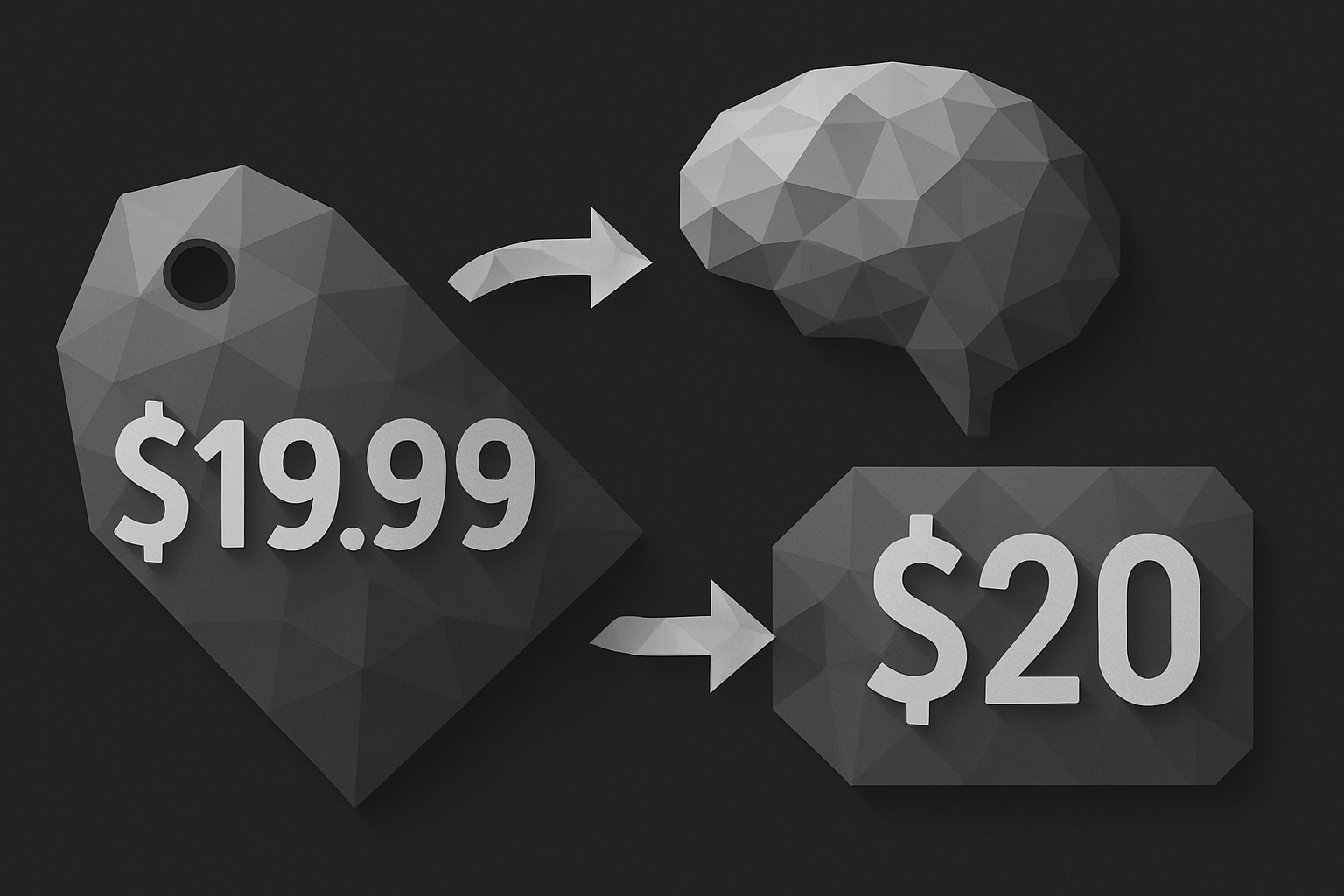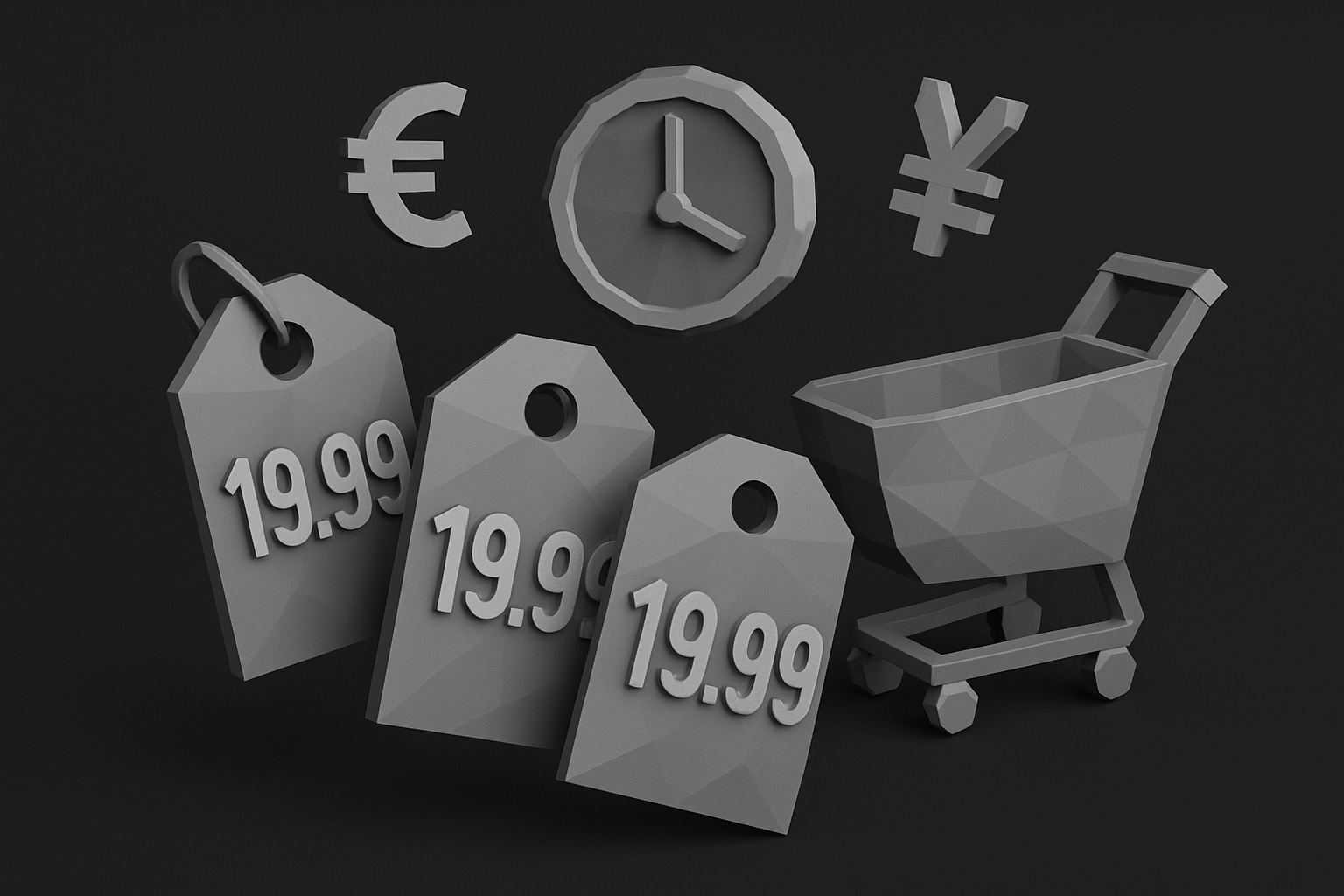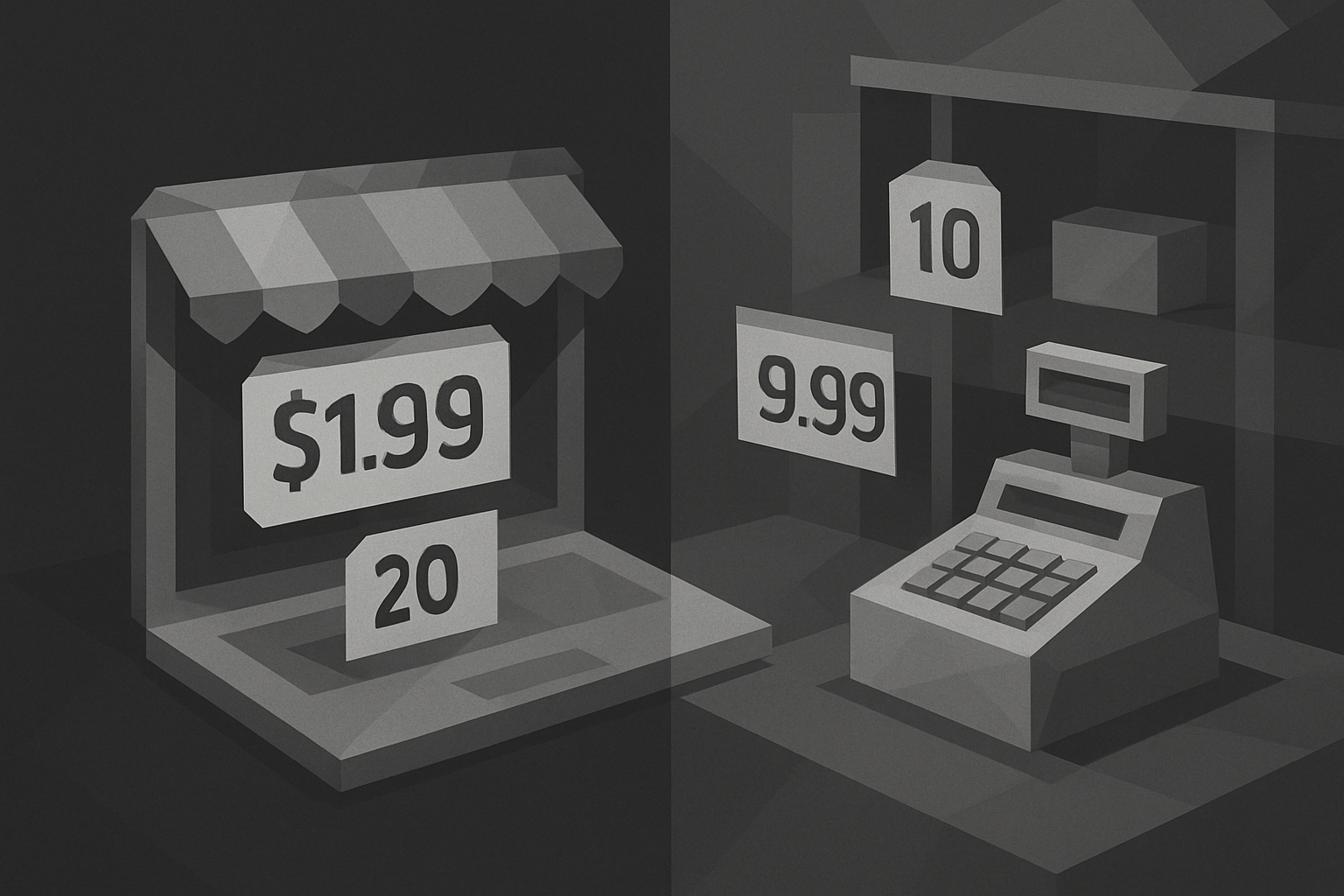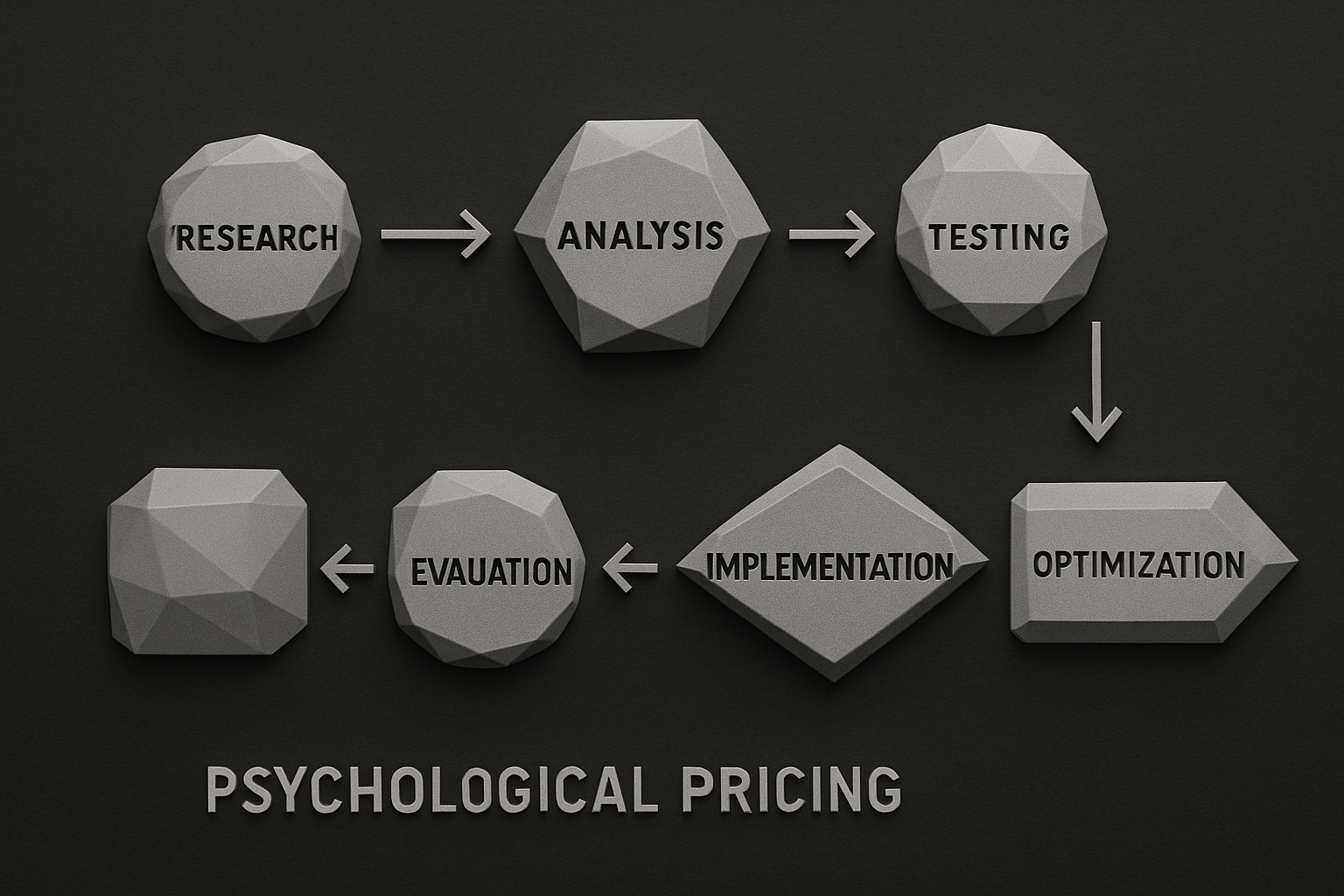Ever wondered why $19.99 feels so much cheaper than $20? That’s the magic of psychological pricing at play—a strategy rooted in consumer psychology rather than simple math.
In today’s fast-paced market, psychological pricing is more than a clever retail trick. It’s a science-backed approach that shapes how buyers perceive value and make decisions.
This guide will break down the essentials, reveal the latest strategies and theories, and give you actionable steps to master psychological pricing in 2025. Ready to discover how smarter pricing can give your business an edge? Let’s dive in.
Understanding Psychological Pricing: The Science Behind the Strategy
Ever notice how your brain reacts more favorably to $19.99 than $20? That’s no accident—psychological pricing is at play. This strategy taps into how consumers perceive and react to numbers, shaping buying decisions in subtle but powerful ways.

Defining Psychological Pricing
Psychological pricing is the practice of setting prices to influence how customers perceive value and make decisions. Instead of relying solely on costs or competitor rates, businesses use tactics like charm pricing, price ending, and just-below pricing to nudge buyers toward a purchase.
For example, $19.99 feels noticeably cheaper than $20, even though the difference is just one cent. This effect is largely due to left-digit bias—our brains latch onto the first number they see, interpreting $19.99 as being in a lower price “zone” than $20.
These small tweaks have a big impact on what people choose to buy and how much they’re willing to spend.
Key Psychological Theories
Several psychological theories explain why psychological pricing works so well. The left-digit effect is one: people anchor on the first number they see and subconsciously round down. Prospect theory suggests buyers weigh gains and losses relative to a reference point—making discounts and price drops seem more significant.
Many shoppers also ignore insignificant digits, such as cents, when evaluating prices. Studies from MIT and the University of Chicago found that price endings like .99 can boost demand, simply because they feel like a better deal.
Want to dive deeper into the science? Check out this in-depth analysis of psychological pricing strategies and their effectiveness in real-world scenarios.
Historical and Market Data Insights
Market data reveals just how widespread psychological pricing is. A 1997 Marketing Bulletin study found that 60% of retail prices ended in 9, 28% in 5, and only 7% in 0. This pattern is especially common in retail stores and gas stations.
| Price Ending | % of Prices (1997) |
|---|---|
| 9 | 60% |
| 5 | 28% |
| 0 | 7% |
Historically, these tactics date back to the days of the UK halfpenny and have evolved globally, especially after the euro’s introduction. Despite changing currencies and technology, psychological pricing points remain stable and effective across markets.
Why Psychological Pricing Works (and When It Doesn’t)
Psychological pricing is effective because consumers often make decisions emotionally, not rationally. While traditional economic models assume buyers act logically, real-world behavior is swayed by subconscious cues.
However, psychological pricing isn’t foolproof. For high-involvement or luxury purchases, buyers may see odd price endings as cheap or inauthentic. That’s why upscale retailers often use even or round numbers to signal quality and prestige.
Ultimately, understanding where psychological pricing shines—and where it doesn’t—can help brands fine-tune their approach for maximum impact.
Core Psychological Pricing Strategies for 2025
Unlocking the real power of psychological pricing in 2025 means using a toolkit of proven strategies. From classic charm pricing to the art of price presentation, each method taps into how our brains process value and make purchase decisions. Let’s break down the core approaches that will shape the future of pricing—and show you how to put them to work.

Charm Pricing (Just-Below Pricing)
Charm pricing is the backbone of psychological pricing. It involves ending prices in 9, 7, or 5—think $99.99 instead of $100. This small tweak leverages the left-digit effect: our brains focus on the first number, making $19.99 feel much cheaper than $20, even though the difference is just a penny.
Retailers love this strategy because it works. In fact, about 60% of advertised prices end in 9, according to the Marketing Bulletin. Charm pricing is everywhere, from e-commerce to your local grocery store, and it remains a powerful psychological pricing tool for boosting sales.
Artificial Time Constraints and Scarcity
Creating a sense of urgency is a psychological pricing staple. Limited-time offers, flash sales, and countdown timers trigger FOMO (fear of missing out), nudging shoppers to act fast. Ever noticed how Black Friday deals vanish in hours? That’s urgency at play.
JCPenney famously learned the hard way when it dropped sales events—customers lost interest without the thrill of scarcity. But beware: overusing these tactics can backfire, making buyers skeptical. Used sparingly, time constraints are a psychological pricing lever that drives quick decisions and spikes in demand.
Price Appearance and Presentation
How a price looks can be just as important as the price itself. Psychological pricing research shows that shorter, simpler prices (like “19” instead of “$19.00”) feel cheaper. Even font size and the presence of currency symbols matter—upscale restaurants often drop the dollar sign to soften price perception.
Small tweaks, like shrinking the font size for cents, make the price feel less significant. For a deep dive on structuring prices to maximize conversions, check out Product landing page strategies, which explores the nuances of price presentation and framing for digital storefronts.
Anchoring and Price Framing
Anchoring is a psychological pricing technique that sets a reference point—usually a higher price—so subsequent prices seem like bargains. For example, SaaS companies highlight their “premium” tier first, making standard plans feel like deals.
Presenting prices in descending order or using “was $199, now $99” frames the offer as a substantial savings. Data confirms that anchoring boosts perceived value and increases willingness to pay. In 2025, mastering anchoring will be essential for businesses seeking to optimize psychological pricing and outshine competitors.
Innumeracy and Offer Structuring
Many shoppers aren’t math whizzes, and psychological pricing exploits this with creative offer structuring. “Buy one, get one free” feels more generous than “50% off two,” even though the savings are identical. This is because consumers struggle with percentages and multi-step calculations.
Double discounts, carefully designed coupons, and bundled offers all play into this innumeracy. Akshay Rao’s University of Minnesota studies show people consistently choose offers that feel simpler, regardless of actual value. Psychological pricing thrives when deals are intuitive, not confusing.
Prestige Pricing and Price Banding
Not all psychological pricing relies on discounts. Prestige pricing uses round numbers—like $500 or $1,000—to signal luxury and exclusivity. High-end brands often avoid odd price endings, associating even numbers with quality and trust.
Price banding is another tactic: keeping prices just below a search filter cutoff (e.g., $499 instead of $500) ensures products appear in more results. Gilt Groupe, for example, uses 0s or 5s for original prices and 7s, 8s, or 9s for discounts. These psychological pricing strategies help position products for both value and aspiration.
Consumer Behavior Trends and Insights for 2025
As we approach 2025, consumer behavior around psychological pricing continues to evolve rapidly. The rise of digital payments and changing shopping habits are reshaping how people perceive prices—both online and offline. Businesses must adapt to these shifts to stay ahead.

Shifts in Digital and In-Person Shopping
Digital payments are now mainstream, reducing concerns like awkward change and making purchases feel more frictionless. Online platforms use search filters and price banding, influencing how psychological pricing is displayed. E-commerce retailers can easily test price endings or apply dynamic pricing at scale.
Physical stores, meanwhile, still rely on classic tactics—like charm pricing and sale signage—to nudge decisions. Yet, digital tools are catching up in brick-and-mortar via mobile payments and digital receipts. As psychological pricing strategies adapt, businesses must watch both channels closely to optimize performance.
The Role of Heuristics and Cognitive Biases
Consumers rarely process prices rationally. Instead, they rely on cognitive shortcuts—anchoring, the left-digit effect, and price perception heuristics—to make quick decisions. Psychological pricing leverages these biases: a price of $4.99 feels meaningfully cheaper than $5, even if the difference is a single cent.
Research by Keith Coulter shows font size and price presentation can also sway perception, making a price seem lower. Understanding these mental shortcuts is crucial for businesses aiming to use psychological pricing effectively.
Demographic Differences and Market Segmentation
Not all consumers react to psychological pricing the same way. Younger shoppers, raised on online deals, may be more sensitive to charm prices and digital discounts. Older consumers might prefer straightforward, round pricing—especially for bigger purchases.
Regional and cultural differences also matter. In the US, gas prices often end in 9/10ths, while European markets have shifted their practices since the euro's introduction. Luxury shoppers, regardless of age, tend to trust even or round prices over psychological pricing tactics.
| Demographic | Price Sensitivity | Preferred Price Ending |
|---|---|---|
| Gen Z/Millennial | High | .99, .95, .97 |
| Gen X/Boomer | Moderate | .00, .50, .99 |
| Luxury Buyers | Low | .00 (round numbers) |
The Impact of Overexposure and Consumer Savviness
Consumers are getting wiser to psychological pricing tricks. Constant sales, endless “limited-time” offers, and perpetual discounts can lose their power if overused. Shoppers may start to distrust a brand or wait for better deals, eroding long-term loyalty.
High-end brands have noticed this trend, reverting to whole numbers to reinforce premium positioning. Striking a balance between using psychological pricing and maintaining credibility is essential for sustained success.
Data-Driven Optimization and A/B Testing
With the abundance of digital tools, brands can now test psychological pricing strategies with precision. A/B testing lets businesses compare charm pricing against round pricing, measuring which drives higher conversions or average order values. Real-world data, such as those found in recent Pricing Psychology Statistics (2025), highlight the measurable impact of these tactics.
Continuous optimization—adapting prices for audience segments and products—ensures psychological pricing remains effective as consumer expectations shift. Data-driven experimentation is now a must-have for modern pricing strategy.
Step-by-Step Guide: Implementing Psychological Pricing in Your Business
Ready to put psychological pricing to work for your business? Follow this step-by-step roadmap to ensure every price you set is backed by science, strategy, and a customer-centric mindset. Each step builds on the last—so whether you’re new to psychological pricing or optimizing your approach for 2025, you’ll find practical guidance here.

Step 1: Understand Your Audience and Market Position
Start your psychological pricing journey by truly knowing your customer. Who are your buyers? What motivates their spending? Segment your audience by demographics, buying habits, and price sensitivity.
Analyze your competitors’ psychological pricing tactics. Are they using charm pricing, scarcity, or prestige cues? Collect data on consumer preferences in your niche using surveys, analytics, and direct feedback.
- Identify key customer segments
- Assess competitive pricing landscapes
- Gather real purchase data
Understanding these insights ensures your psychological pricing isn’t just theory—it’s tailored for your unique market.
Step 2: Choose the Right Psychological Pricing Strategies
Not every psychological pricing technique fits every business. Match your tactics to your brand, product, and audience.
For everyday items, charm pricing ($9.99) often works best. Luxury brands may prefer round numbers to signal exclusivity. New products might benefit from introductory pricing, while established goods can leverage bundling or anchoring.
Ask yourself:
- Is my product a commodity or a luxury?
- Are my customers deal-seekers or quality-focused?
- What strategies are my competitors using?
Choosing the right psychological pricing approach sets the stage for revenue growth and customer loyalty.
Step 3: Structure and Present Your Prices Effectively
How you display prices is just as critical as the numbers themselves. Psychological pricing thrives on subtle cues—like ending prices in 9, simplifying digits, or adjusting font sizes.
Compare these two price tags:
| Price Format | Perceived Value |
|---|---|
| $19.99 | Lower |
| $20.00 | Higher |
| 19 | Lowest |
- Use fewer digits for a cheaper feel
- Minimize currency symbols for upscale perception
- Try price anchoring: show original and discounted prices side by side
Thoughtful presentation amplifies the effects of psychological pricing and helps guide buyer decisions.
Step 4: Leverage Urgency, Scarcity, and Bundling
Create momentum with psychological pricing by adding urgency and scarcity. Limited-time offers, flash sales, and “only X left” notices can nudge hesitant shoppers across the finish line.
- Announce one-day-only deals
- Highlight low stock or limited editions
- Bundle products for perceived value
But beware: overusing urgency can erode trust. Balance scarcity with honesty to keep psychological pricing both effective and credible.
Step 5: Test, Measure, and Optimize
No psychological pricing strategy is set-and-forget. A/B testing is your best friend. Experiment with different price endings, framing, and offers to see what resonates.
Track key metrics:
- Conversion rates
- Average order value
- Customer lifetime value
Analyze the data, iterate, and refine. Psychological pricing is a dynamic process—what works today may need tweaking tomorrow. Let the numbers guide your next move.
Step 6: Adapt for Digital Products and Online Sales
Digital products require a modern twist on psychological pricing. E-commerce platforms, SaaS, and online courses all benefit from tailored strategies.
Leverage dynamic pricing, personalized offers, and tiered subscriptions. For more in-depth strategies, check out Building digital products profitably.
- Test charm pricing on subscription tiers
- Use anchor pricing for software plans
- Adapt price presentation for mobile and desktop
Digital-first businesses can unlock new revenue streams by mastering psychological pricing online.
Step 7: Maintain Brand Integrity and Customer Trust
The final step in psychological pricing is protecting your reputation. Transparent communication builds loyalty—manipulative tactics can destroy it.
- Avoid hidden fees or drip pricing
- Clearly explain discounts and offers
- Balance urgency with authenticity
A trustworthy approach to psychological pricing ensures your customers feel valued, not tricked. In the long run, this fosters lasting relationships and repeat business.
Advanced Tips and Best Practices for Psychological Pricing in 2025
Mastering psychological pricing requires more than just clever price endings. As we look to 2025, the most effective brands will blend proven tactics with cutting-edge tools and ethical, customer-centric thinking. Let’s explore the advanced strategies you need to stay ahead.
Integrating Psychological Pricing with Overall Pricing Strategy
For psychological pricing to deliver sustainable results, it must align with your broader pricing approach—whether that’s cost-plus, value-based, or competitive. Consistency across all channels is crucial. Imagine a customer seeing one price online and another in-store; trust erodes fast.
Omnichannel retailers often unify their psychological pricing strategies to avoid confusion. For example, a brand might use charm pricing in both physical and digital storefronts, ensuring every touchpoint feels familiar.
A quick table to compare approaches:
| Strategy | Best For | Example |
|---|---|---|
| Cost-plus | Commodities | Grocery chains |
| Value-based | Luxury, tech | High-end electronics |
| Competitive | E-commerce, retail | Fast fashion brands |
| Psychological | All segments | SaaS, retail, services |
Blending psychological pricing with these models enhances perceived value and supports your brand story.
Using Technology and AI for Smarter Pricing Decisions
Today’s leaders leverage AI and automation to optimize psychological pricing in real time. Dynamic pricing engines scan the market, track trends, and suggest adjustments that maximize revenue without alienating customers.
Modern AI tools can segment audiences and personalize prices based on behavior, location, or purchase history. This means you can test and refine charm pricing, bundling, or anchoring strategies at scale.
For a closer look at essential software to support these efforts—including A/B testing platforms and analytics—check out this list of the best digital marketing tools. Adopting the right tech stack keeps your psychological pricing agile and effective.
Ethical Considerations and Regulatory Compliance
As psychological pricing gains popularity, so does scrutiny. Regulators are increasingly focused on transparency and fairness, especially regarding hidden fees or “drip pricing.” Staying compliant isn’t just about avoiding fines—it’s about building lasting trust.
Ethical psychological pricing means being upfront with your customers. Avoid misleading tactics, like inflating “original” prices or burying important details in the fine print. Customers are savvy and will reward brands that prioritize honesty.
Recent regulatory actions worldwide highlight the need for clear, accurate pricing displays and truthful promotional claims. Make compliance a cornerstone of your pricing strategy.
Customizing Psychological Pricing for Global Markets
Psychological pricing isn’t one-size-fits-all. Different countries—and even regions—respond uniquely to price endings, currency symbols, and presentation. For example, after the euro’s introduction, many European retailers adjusted their strategies to fit new cultural norms.
Research regional preferences before rolling out psychological pricing internationally. In some markets, round numbers signal trust and quality; in others, charm pricing remains king. Adjusting for currency differences and local behaviors helps you connect authentically.
Localization also extends to language, payment methods, and online shopping habits. Tailor your approach for each market to maximize impact.
Case Studies: Successes and Pitfalls
Learning from real-world examples can sharpen your psychological pricing instincts. Consider Costco’s $1.50 hot dog deal—it’s legendary for perceived value and customer loyalty. On the flip side, JCPenney’s attempt to eliminate sales and use “fair” pricing backfired, leading to plummeting sales and a quick strategy reversal.
Gilt Groupe’s use of round numbers for original prices and odd numbers for discounts illustrates how subtle cues influence perception. For more in-depth examples of psychological pricing in action, visit this resource on psychological pricing strategies to boost sales and revenue.
These stories show that context, audience, and execution matter as much as the tactic itself.
Common Mistakes to Avoid
Even seasoned pros can slip up with psychological pricing. Here are pitfalls to watch for:
- Overusing discounts or urgency, which can devalue your brand
- Ignoring performance data or failing to run A/B tests
- Sticking to one tactic without adapting to market changes
- Neglecting transparency, which can erode trust
Keep your psychological pricing fresh by monitoring results and listening to customer feedback. The best brands evolve their strategies as consumer expectations shift.
Future Trends: The Evolution of Psychological Pricing
As we look ahead, psychological pricing is rapidly evolving. Shifts in technology, consumer expectations, and global trends are shaping how businesses approach pricing strategy. Here’s what to watch in 2025 and beyond.
The Rise of Personalization and Hyper-Targeted Pricing
Personalization is transforming psychological pricing. With AI and big data, businesses can now analyze individual buying patterns and deliver hyper-targeted prices. Imagine logging into an e-commerce site and seeing offers tailored just for you—this is already happening.
Personalized psychological pricing increases conversion rates by making offers feel more relevant. Brands test different price points, endings, and bundles based on your browsing habits. As privacy regulations tighten, companies must balance personalization with transparency, ensuring trust is maintained at every step.
Subscription Models and Digital Product Pricing
The digital economy’s expansion means psychological pricing is being reimagined for SaaS, online courses, and streaming services. Subscription models rely heavily on pricing psychology—think charm pricing for monthly plans or anchoring with “premium” tiers.
For a deeper dive into how these tactics are used, see The Art of Psychological Pricing in Subscription Software Sales. Tiered pricing, free trials, and limited-time discounts play on consumer biases, encouraging upgrades and reducing churn. As digital products multiply, expect psychological pricing strategies to get even more sophisticated.
The Impact of Inflation and Economic Uncertainty
Economic shifts are forcing brands to rethink psychological pricing. With inflation and global uncertainty, consumers scrutinize value more closely. Businesses use strategic price points—like “just under” increases or shrinkflation—to soften the blow of higher costs.
Communicating value becomes essential. Psychological pricing helps by reframing price hikes as small, manageable steps. Yet, if consumers sense manipulation, trust erodes. Transparent communication and clear value propositions are the keys to navigating these turbulent times.
Sustainability and Value-Based Pricing
Consumers are increasingly motivated by values, not just price tags. Brands that champion sustainability are using psychological pricing to highlight their ethical commitments—often through premium pricing for eco-friendly goods.
Value-based psychological pricing communicates more than affordability; it signals impact and quality. For example, rounding up prices or donating a portion to environmental causes can make higher prices feel justified. In 2025, expect more brands to blend purpose with pricing psychology.
The Role of Social Proof and Community Influence
Social proof is now a powerful lever in psychological pricing. Reviews, testimonials, and “most popular” badges guide shoppers toward certain price points. When a plan is labeled as the “best value,” it anchors expectations and nudges decisions.
Peer behavior and community influence are amplified by social media. Psychological pricing leverages this by showcasing trending products, limited stock alerts, and what others are buying. This blend of pricing psychology and social validation will only grow stronger.
Preparing for Regulatory and Technological Disruption
The future of psychological pricing isn’t just about consumer trends—it’s shaped by regulation and tech innovation. New laws are demanding more transparency in pricing, targeting tactics like hidden fees and drip pricing.
At the same time, payment technologies—from cryptocurrencies to mobile wallets—are changing how consumers perceive and interact with prices. Businesses must stay agile, updating psychological pricing strategies to stay compliant and competitive in a fast-changing landscape.
| Trend | Impact on Psychological Pricing |
|---|---|
| AI Personalization | Enables hyper-targeted pricing |
| Regulation | Demands greater transparency |
| Payment Innovation | Alters pricing perception and tactics |
Psychological pricing is entering a new era. By staying ahead of these trends, businesses can optimize revenue and build lasting trust with consumers.
Now that you’ve got a handle on the latest psychological pricing strategies for 2025, you might be wondering how to actually put them into action for your digital products or online business. The good news is, you don’t have to figure it all out alone—we’re here to help you turn those insights into sales, automate your offers, and build a brand that stands out. If you’re ready to take the next step and transform your expertise into a self-sustaining business, let’s make it happen together—Get Started.